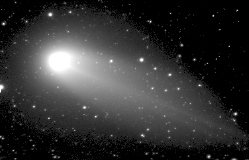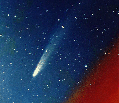 |
|
Comet
Hyakutake
|
|
Comets are formed of dust and icy
gases. They travel highly elliptical orbits that bring
them close to the Sun, then swing them back, deep into
space. Usually the farthest point of their journey is
beyond the distance of Pluto's orbit. Close to the heat
of the Sun, comets develop tails millions-of-miles in
length, some creating easily viewable spectacles as they
visit the vicinity of Earth.
In centuries past, comets seemed to appear suddenly, generating
excessive reactions from people who did not understand
them. They were blamed for everything from the death of
kings to the demise of great empires to the creation of
plagues. The passage of
| |
|
| |
 |
| |
An image of Comet Halley from the Bayeux Tapestry
|
Halley's Comet in 1066, for example,
appeared to foretell of the English loss at the Battle
of Hastings. More recently, during its 1910 passage, the
infant science of spectroscopy discovered toxic gases
in Halley's Comet. Fearing that the Earth would pass through
the poisonous tail, charlatans sold comet insurance policies
and homeopathic medicines for the coming "comet fever."
To probe the mysteries of comets, the NASA Stardust spacecraft
will fly close to a comet and, for the first time ever,
bring material back to Earth for analysis by scientists
worldwide. This cometary material, it is hoped, will help
unlock some of the secrets of these small bodies that
are often described as "dirty ice balls" hurling
through space. By learning
something about these little bits of a comet, scientists
hope it may be possible to discover more far reaching
secrets about the materials that make up our universe
and possibly more about its origins. A big question that
scientists hope to better answer is whether comets brought
water to the Earth.
| |
|
 |
|
Comet
Kohoutek
|
|
Please explore the Stardust
mission website to learn more about this fascinating
mission, the technologies used to pursue it, find out
more about educational opportunities and the scientific
knowledge it aspires to gather.
| Last updated November
26, 2003 |
|
